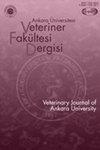First dose optimization study on freezing Anatolian buffalo semen
IF 0.9
4区 农林科学
Q3 VETERINARY SCIENCES
引用次数: 0
Abstract
The main objective of sperm production centers is to produce as many straws as possible from the obtained ejaculates using the optimal dilution rate. To this end, this study is the first to evaluate the effect of different semen extender rates on Anatolian buffalo semen quality. Ejaculates were collected by artificial vagina from three Anatolian buffalo bulls (n=105). These ejaculates were divided into three aliquots and filled into 0.25 ml straws with soy-based extenders at the concentrations of 35, 25, and 15 million spermatozoa/straw. The straw samples of different spermatozoa concentrations were frozen. The quality of spermatozoa was evaluated after thawing (37 °C, 30 sec) and following the thermoresistance test (37 °C, 3 h). The post-thaw total motility and progressive motility values were similar between the groups. However, following the thermoresistance test, there was a significant decrease in total motility in the 35 million spermatozoa/straw group, and the progressive motility was significantly higher in the 25 million spermatozoa/straw group. There was no statistically significant difference between the groups in terms of sperm kinetic parameters, except VSL after thawing except the VAP and LIN values following the thermoresistance test. In conclusion, it is recommended to dilute the Anatolian buffalo semen at a concentration of 25 or 100 million spermatozoa/ml per straw when freezing it with a soy-based semen extender. In addition, it is considered that soy-based extenders compensate for cryo-damage to sperm motility for a short time, and the thermoresistance test should be applied for objective evaluation in dose optimization studies.安纳托利亚水牛精液冷冻首次剂量优化研究
精子生产中心的主要目标是使用最佳稀释率从获得的射精中生产尽可能多的吸管。为此,本研究首次评价了不同增精率对安纳托利亚水牛精液质量的影响。用人工阴道收集了3头安纳托利亚水牛的射精(n=105)。这些射精被分成三等分,分别以35、25和1500万个精子/吸管的浓度用大豆为基础的扩展剂填充到0.25 ml的吸管中。将不同精子浓度的吸管样品冷冻。在解冻(37°C, 30秒)和耐热性测试(37°C, 3小时)后评估精子的质量。解冻后两组精子的总运动性和渐进运动性值相似。然而,经过耐热性测试,3500万精子/吸管组的总运动性显著降低,2500万精子/吸管组的进行性运动性显著升高。除解冻后的VSL外,各组间除热阻试验后的VAP和LIN值外,其他精子动力学参数差异均无统计学意义。综上所述,建议在冷冻安纳托利亚水牛精液时,用大豆基精液扩增剂稀释浓度为每根吸管25或1亿个精子/ml。此外,认为大豆基扩展剂可在短时间内补偿精子活力受到的低温损伤,在剂量优化研究中应采用耐热性试验进行客观评价。
本文章由计算机程序翻译,如有差异,请以英文原文为准。
求助全文
约1分钟内获得全文
求助全文
来源期刊
CiteScore
1.50
自引率
0.00%
发文量
44
审稿时长
6-12 weeks
期刊介绍:
Ankara Üniversitesi Veteriner Fakültesi Dergisi is one of the journals’ of Ankara University, which is the first well-established university in the Republic of Turkey. Research articles, short communications, case reports, letter to editor and invited review articles are published on all aspects of veterinary medicine and animal science. The journal is published on a quarterly since 1954 and indexing in Science Citation Index-Expanded (SCI-Exp) since April 2007.

 求助内容:
求助内容: 应助结果提醒方式:
应助结果提醒方式:


